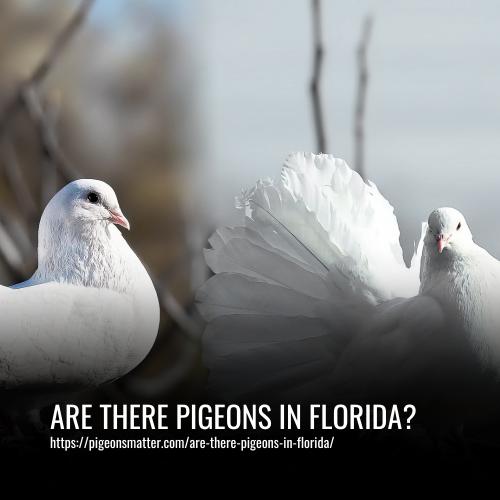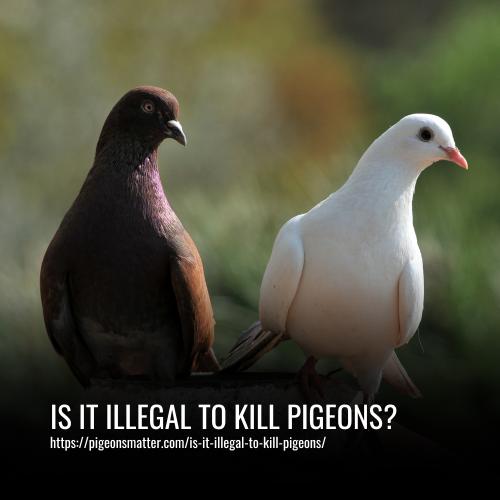Killing pigeons should only be considered as a last resort. Shooting is one method that can be used, but it is important to check local laws and regulations regarding the use of firearms. Using poison to kill pigeons is not recommended as it can be harmful to other animals and pets. It is always better to try humane methods of deterrence or seek professional help to remove pigeons from your property.
To Kill Pigeons, Follow These Steps:
- Shooting
- Trapping Pigeons
- Poisoning
- Rice or Alka Seltzer

How To Kill Pigeons
If killing pigeons is the only solution to removing them from an area, it must be done in a humane way.
1. Shooting
Shooting is a traditional method of controlling pigeon populations, but it has several drawbacks. Using an air rifle requires great marksmanship to be effective, and even a well-targeted shot may not result in an instant kill. This can cause the bird to suffer severe pain before eventually dying, which is inhumane.
Additionally, shooting is not a suitable method in urban areas due to safety concerns, so it is mostly restricted to rural areas. If you do choose to use shooting as a method of pigeon control, it is best to hunt at night when the birds are usually inactive. However, it’s important to consider more humane and effective methods of control, such as trapping and relocation.
Is Shooting Pigeons an Acceptable Method of Control?
While shooting pigeons may be an acceptable method of control in certain circumstances, there are many limitations to consider. It is important to note that shooting in urban areas is strictly prohibited and can result in legal consequences. Even shooting birds on your own property is not recommended, as it can lead to unintended consequences.
Unless you are in a remote or rural location, shooting pigeons is not an acceptable option. Additionally, it is important to note that all OSHA-inspected facilities prohibit guns in the workplace, which further limits the use of shooting as a control method. The only situation where shooting remains a viable option is on a rural farm.
2. Trapping Pigeons
When it comes to trapping pigeons, live traps are the only humane option. There are several types of live traps available, but they all work in a similar way. The trap is baited with grains during a conditioning period, allowing the pigeons to enter and exit through a door.
Once the pigeons are acclimated, the door is switched to one-way, preventing the birds from leaving the trap. However, it’s important to note that trapped pigeons cannot be relocated as they have a strong homing ability and will likely return to their original location. Therefore, euthanizing the trapped pigeons is necessary. It’s crucial to follow humane methods when trapping pigeons to ensure their welfare.
Lethal trapping
There are different methods to kill pigeons, but it’s important to exercise caution and follow instructions carefully to avoid injury. Lethal traps can be effective, but it’s crucial to set them up correctly and not harm yourself in the process. Consider calling in a professional to handle this task.
When using lethal traps, place them in a strategic location where pigeons frequently roost and bait them with grains, seeds, or fruits. However, live traps may be a better option as they can capture the birds without killing them outright. Once caught, pigeons can be killed humanely by introducing poisonous gas or snapping their necks with special pliers.
It’s important to note that killing pigeons should be a last resort and only done if absolutely necessary. Consider other methods of deterring or managing their populations, such as using bird spikes or netting or contacting a wildlife rehabilitator for assistance.
Can Trapping be Combined with Other Methods of Control?
Integrated pest management (“IPM”) philosophy supports the combination of lethal and non-lethal methods for effective pest control. Trapping, a lethal method, can be used in conjunction with other non-lethal methods to manage the pigeon population.
For instance, a trapping program can be implemented alongside birth control to reduce pigeon reproduction and increase mortality. This approach can lead to the best possible outcome for managing the pigeon population. By combining different methods, the impact of each method can be maximized, resulting in a more effective and sustainable approach to pest control.
Raptors for Pigeon Control
The most effective way to control pigeons is through the use of natural predators, such as raptors or birds of prey. Pigeons are considered a prey species and are commonly hunted by various hawks, owls, and falcons. The Peregrine falcon is particularly skilled at catching pigeons in mid-air. However, it’s important to note that these natural predators are not within our immediate control.
The best option for attracting raptors is to install nesting habitats, such as owl boxes, which can be obtained through your State Coop Extension Service. By providing suitable habitats for these birds, you can encourage them to take up residence and help control the pigeon population in your area. It’s important to remember that these methods may take some time to be effective and may not completely eliminate the pigeon problem. Therefore, it’s recommended to use a combination of methods to achieve the best results.
3. Poisoning
Using poisons to kill pigeons comes with several drawbacks and is restricted in many countries. Poisoned bait can also harm other animals in the area, leading to unintended deaths. Additionally, poisoned pigeons may die in hidden areas, creating a foul odor and the responsibility of disposing of the carcass.
There are several types of poisons used to kill pigeons, each with a different mechanism. Alphachloralose is often used in treated grains, causing the pigeons to feel stupor-like before dying. However, they may die in unwanted areas where other animals can also be poisoned.
Avitrol contains a toxicant that causes convulsive reactions in pigeons before they eventually die. However, it can also harm other animals, so caution is necessary. Thallium can be administered through inhalation or oral consumption and induces nausea, vomiting, and pain before killing the pigeon.
Antifreeze is another commonly used poison to kill pigeons. It is important to note that using poisons to kill pigeons can have unintended consequences and should be avoided if possible.
How Effective Is Poisoning Pigeons?
While poisoning pigeons may seem like an effective method of control, it ultimately only provides a temporary solution. While the immediate effect may be noticeable, the remaining flock quickly repopulates, resulting in a chronic cycle of killing with little long-term effect.
Pigeons breed quickly, so a site that poisons half of its population will soon have the same number of birds. This makes poisoning pigeons an ineffective and short-term control strategy. Other methods, such as habitat modification and exclusion, are more effective in the long run.
Using poison to kill pigeons – good or bad idea?
While pigeons are often seen as pests, it’s important to remember that they are still living creatures and should be treated humanely. Using poison to kill pigeons may seem like a quick solution, but it comes with many risks and hazards. One major risk is the potential for killing the wrong bird. This could result in fines from federal, state, and local wildlife agencies, as well as negative public reactions.
There is also the risk of unintentionally harming pets or other animals that may consume the poisoned pigeons. Additionally, if the dead birds are not immediately found and disposed of, there is a risk of secondary effects on other animals that may consume them. Overall, it’s important to consider alternative, humane methods for getting rid of pigeons. This not only protects the birds themselves but also avoids potential legal and public relations issues.
4. Rice or Alka Seltzer
There are some common misconceptions about what foods or substances are harmful to pigeons. It’s important to dispel these myths to ensure that we don’t harm these birds unintentionally.
Uncooked Rice
Contrary to popular belief, uncooked rice will not kill pigeons. They can digest it without any issues, and if they do have trouble, they can simply regurgitate it. So, it’s perfectly safe to feed pigeons uncooked rice if you’d like.
Alka Seltzer
There is no evidence to suggest that Alka Seltzer is harmful to pigeons. Like humans, birds can burp out the gas produced by the tablet. So, it’s unlikely that Alka Seltzer would cause any harm to pigeons.
However, it’s still important to avoid feeding birds any medication or substances that are not intended for them.
Why Killing Pigeons Doesn’t Work
Rather than rely on cruel methods such as Avitrol, The Humane Society of the United States (HSUS) advocates humane and nonlethal approaches to resolving human-pigeon conflicts. These include a combination of population control measures, such as targeted nest and egg removal or oiling eggs to prevent hatching, coupled with habitat modification and exclusion.
By taking these steps to change an environment that encourages pigeon activity and denies access to food sources, property owners can discourage pigeon populations and stop the targeting of birds for killing.
Nonlethal approaches address the root cause of the problem, preventing ongoing conflicts between people and pigeons rather than simply killing those in the flock without permanently stopping their reproduction or migration. The HSUS is committed to protecting all animals—including people—by promoting compassionate coexistence with wild animal populations.
Alternatives To Killing Pigeons
Dealing with a pigeon problem in urban and suburban areas can be challenging, as killing them is not a viable solution. The best approach is to make the area less attractive to pigeons so that they will not want to land or build nests there. Simple steps such as keeping smelly garbage away from pigeons and not feeding them can help repel these pests.
If these measures do not work, changing the environment is the next step. Most pigeons look for flat areas to land and build nests, so using devices such as netting, spikes, or sticky paint can prevent them from accessing their preferred location.
Preventing pigeons from landing and roosting in your property can help address the problem without harming these birds. It is important to take action to manage pigeon populations to prevent damage to property and potential health risks.
FAQs
There are several methods for removing pigeons, including using bird spikes, netting, or decoys, as well as implementing sound or visual deterrents. You may also consider hiring a professional pest control service for more extensive removal.
It is important to check the local laws and regulations regarding the killing of pigeons, as regulations can vary by location. In some areas, it may be legal to remove pigeons if they are causing damage or posing a health hazard, while in other areas, specific permits or methods may be required.
Yes, there are humane methods for pigeon control, such as using bird spikes, netting, or decoys to discourage pigeons from roosting or nesting on your property. You may also consider implementing sound or visual deterrents to discourage pigeons from staying in the area.
To prevent pigeons from returning, it is essential to eliminate any food or water sources that may attract them. Additionally, consider sealing off entry points and using deterrents to discourage pigeons from roosting or nesting on your property.
Pigeons can carry diseases such as histoplasmosis, cryptococcosis, and psittacosis, which can be transmitted to humans. Additionally, pigeon droppings can create slip and fall hazards, as well as damage buildings and property.
Hiring a professional can ensure that pigeon control is done safely and effectively, without violating any laws or causing harm to other wildlife. Consider consulting with a pest control specialist to determine the best course of action for your specific situation.
There are various methods to kill pigeons, including using firearms, traps, and lethal bait. It is crucial to ensure that any method used complies with local laws and regulations and is done in a humane manner.
Yes, there are non-lethal methods such as using decoys, applying repellents, and modifying the environment to make it less hospitable for pigeons. These methods can help manage pigeon populations without resorting to killing.
Conclusion
Killing pigeons may seem like an easy way to solve your pigeon problem, but it’s not the most effective or humane solution. It’s best to opt for a long-term pest management approach by blocking access points and finding alternative solutions such as traps, deterrents, and repellents.
By taking all of these steps together you’re able to not only bring your pigeon numbers down without majorly affecting the integration into your environment but also ensure that pigeons are treated with respect and cared for in the process.


